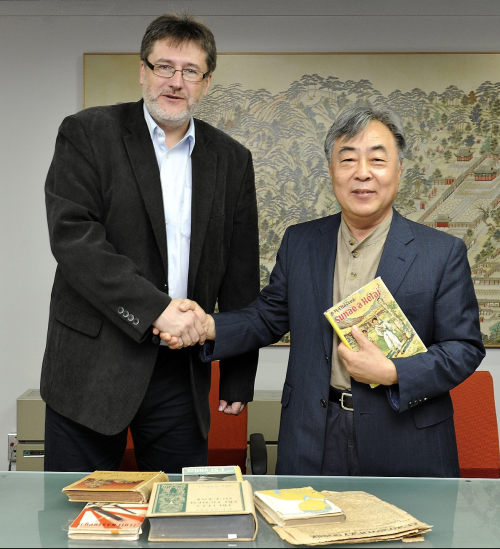The Czech Republic Embassy last week donated 15 books and related newspaper and magazine documents to the Seoul Museum of History that date back almost a century.
“These are travelogues and books written by Czechoslovakian writers who visited in the 1910s and 1920s that are about Korea,” said Czech Republic Ambassador and donator Jaroslav Olsa Jr.
“These are travelogues and books written by Czechoslovakian writers who visited in the 1910s and 1920s that are about Korea,” said Czech Republic Ambassador and donator Jaroslav Olsa Jr.

The process of bringing these books to Korea from the Naprstek Museum of Asian, African and American Cultures in Prague started when Olsa discovered photographs taken by Enrique Sanko Vraz, a Czechoslovakian writer and traveler, during his visit to Seoul in 1901.
“The photos he took of Korea were in the archives,” he said. “Some were used in his books but the majority were never seen and never published before. So when I came to Korea I had an idea to show the photos here.”
That is when the relationship started between the Seoul Museum of History and the Czech Republic Embassy.
A two-month exhibition that attracted over 110,000 visitors started and an accompanying book displaying those photographs followed.
But that was just the beginning.
Next came 15 published works that the Czech Republic government donated last week to the museum.
“It is very reasonable and logical that these Czechoslovakian publications about Korea, that are not available at the National Library of Korea or in the National Assembly Library or even anywhere else in Korea, be made available here,” he said.
Some of the books come with illustrations showing what and how Czechoslovakian writers thought about Korea back then.
Czechoslovakians have always been a curious bunch, the ambassador explained.
“It is a natural Czechoslovakian feature to travel and bring information back home,” he said.
After the fall of the Austro-Hungarian Empire in 1918, Czechoslovakia found itself in a very interesting position.
At the time, the Austro-Hungarian Empire had about 60 million people. When it collapsed after the Second World War, Czechoslovakia ended up with 12 million people and 75 percent of the former empire’s industries.
“The problem was we had production but had no market,” he said. “We had to survive that meant we had to continue to produce.”
That is roughly when the modern diplomatic mission as we know it today started ― one that takes care of trade as well as bilateral and people-to-people relations.
“There were the standard missions in Europe that took care of political issues, but an even greater number of missions were opened as far as Brazil, South Africa, Iran, Jerusalem and Japan, just to name a short few, who’s primary goal was taking care of Czechoslovakian citizens and trade promotion,” he said.
One interesting article found in a Czechoslovakian newspaper reports to their readers back home about the March 1 movement, the first time it appeared in a Czechoslovakian newspaper.
By Yoav Cerralbo (yoav@heraldcorp.com)








![[Kim Seong-kon] Democracy and the future of South Korea](http://res.heraldm.com/phpwas/restmb_idxmake.php?idx=644&simg=/content/image/2024/04/16/20240416050802_0.jpg&u=)







![[KH Explains] Hyundai's full hybrid edge to pay off amid slow transition to pure EVs](http://res.heraldm.com/phpwas/restmb_idxmake.php?idx=652&simg=/content/image/2024/04/18/20240418050645_0.jpg&u=20240418181020)

![[Today’s K-pop] Zico drops snippet of collaboration with Jennie](http://res.heraldm.com/phpwas/restmb_idxmake.php?idx=642&simg=/content/image/2024/04/18/20240418050702_0.jpg&u=)